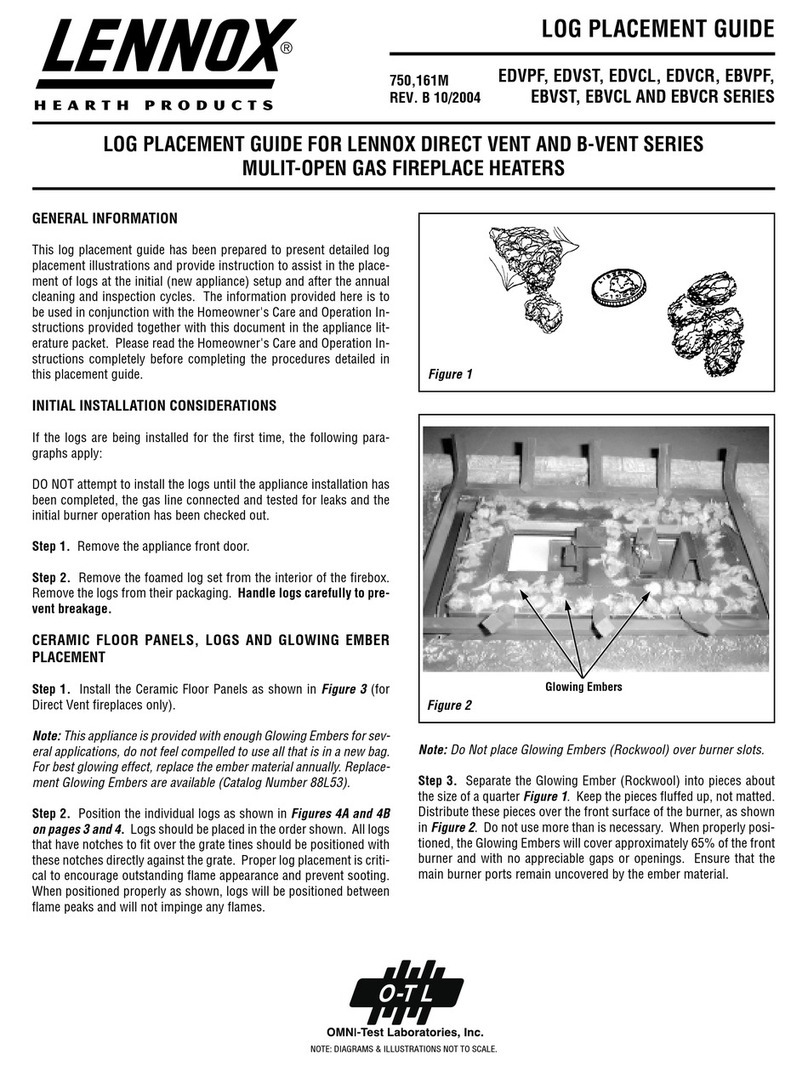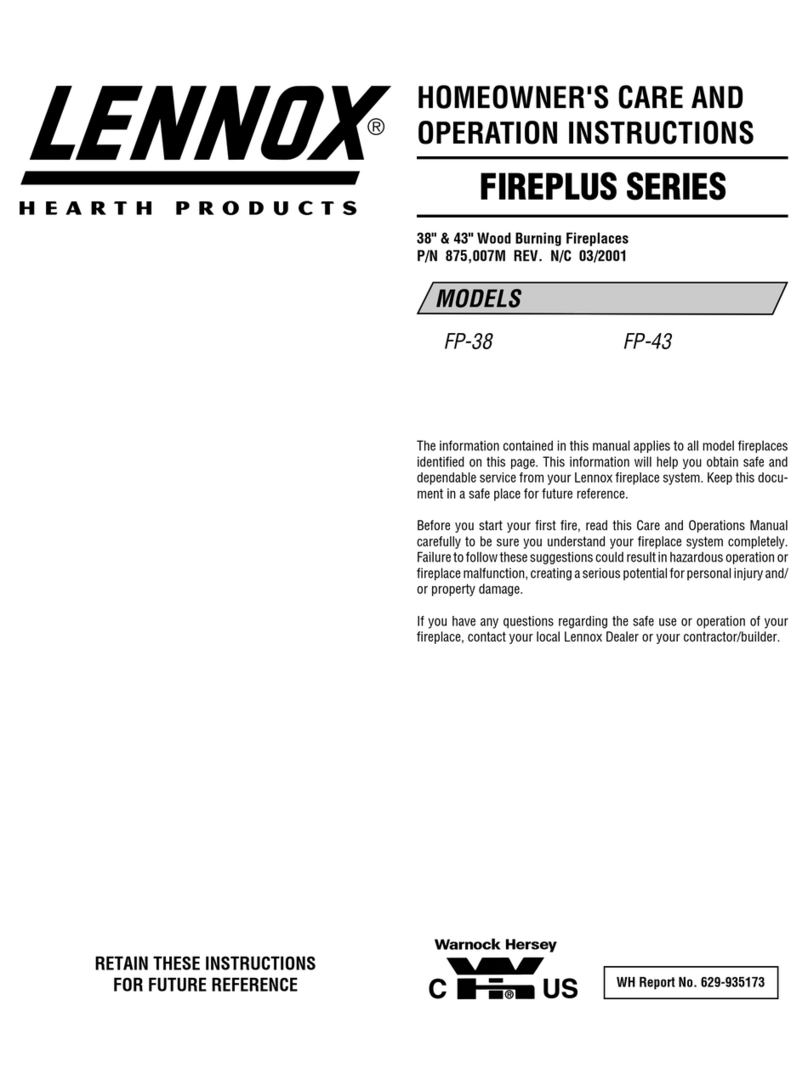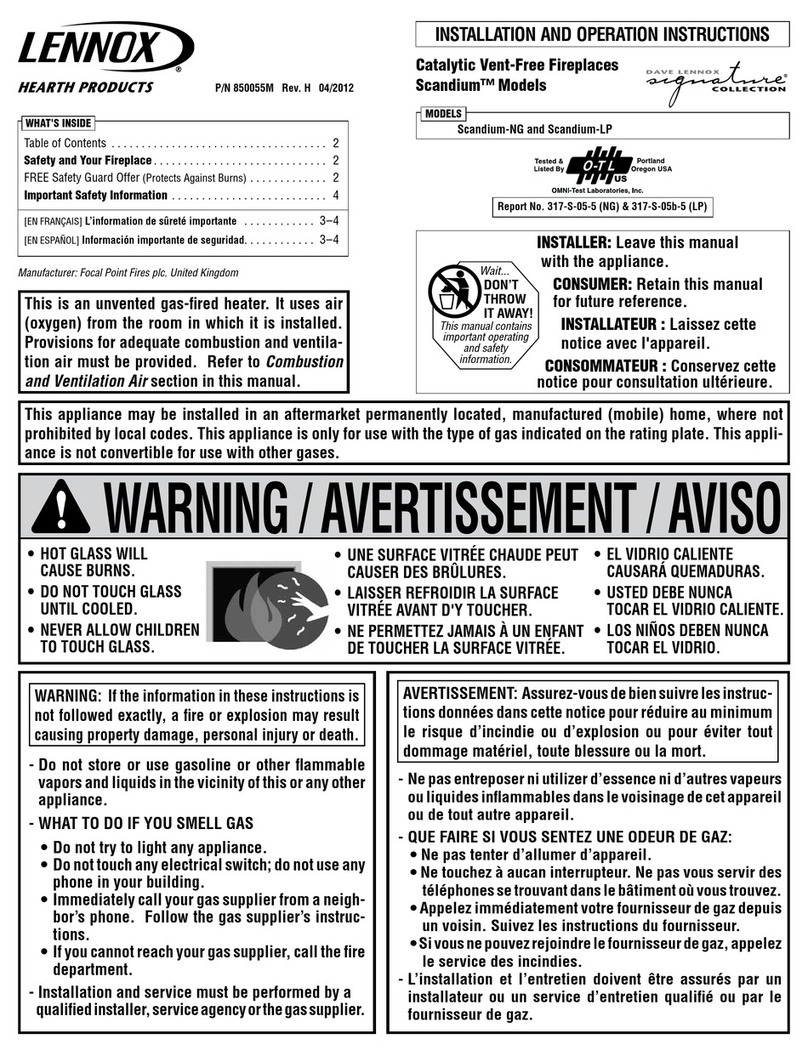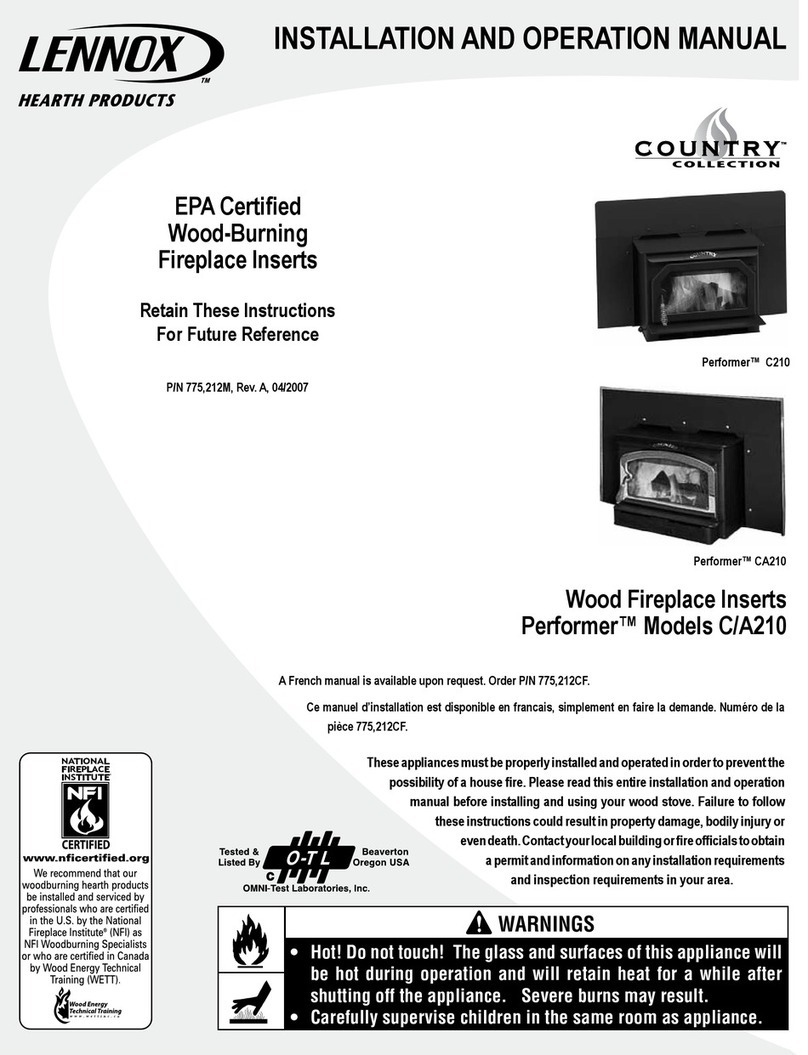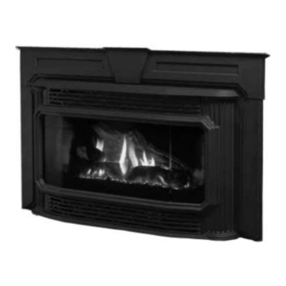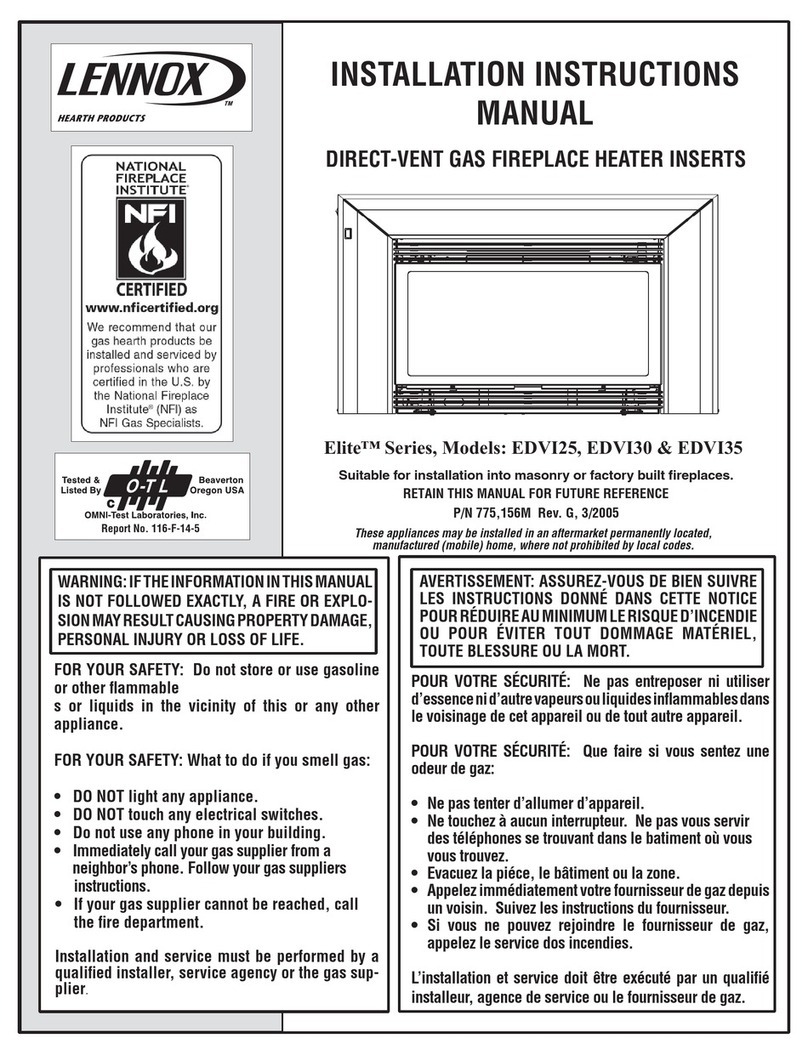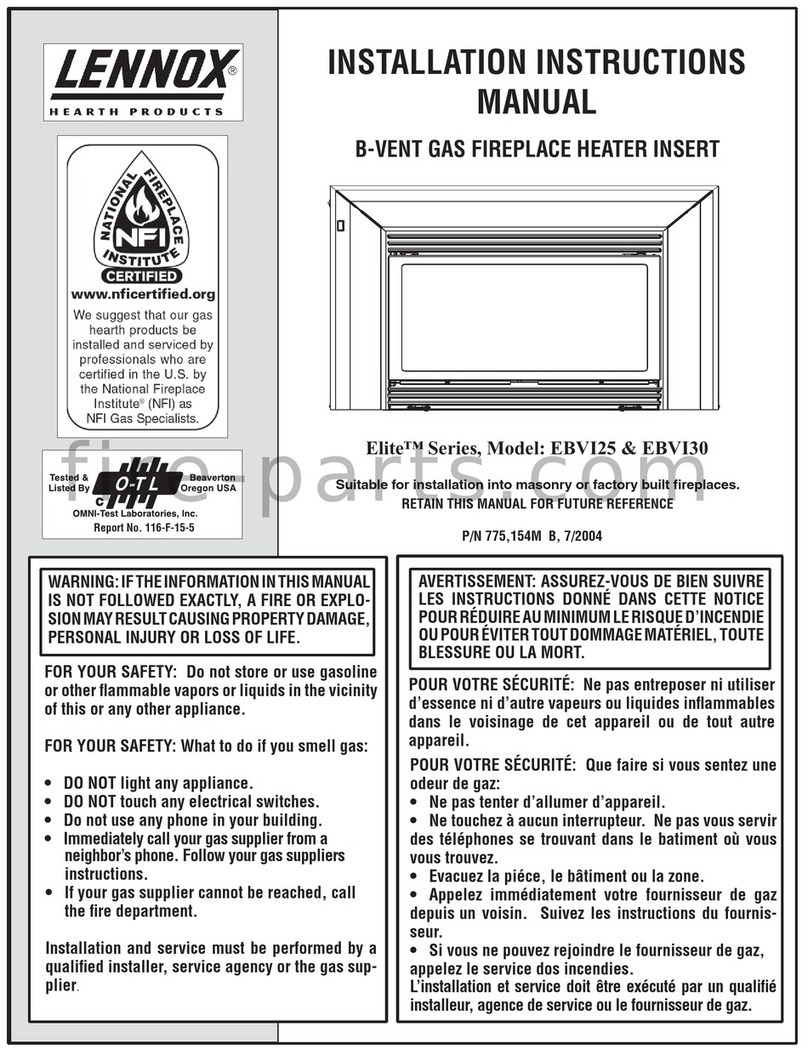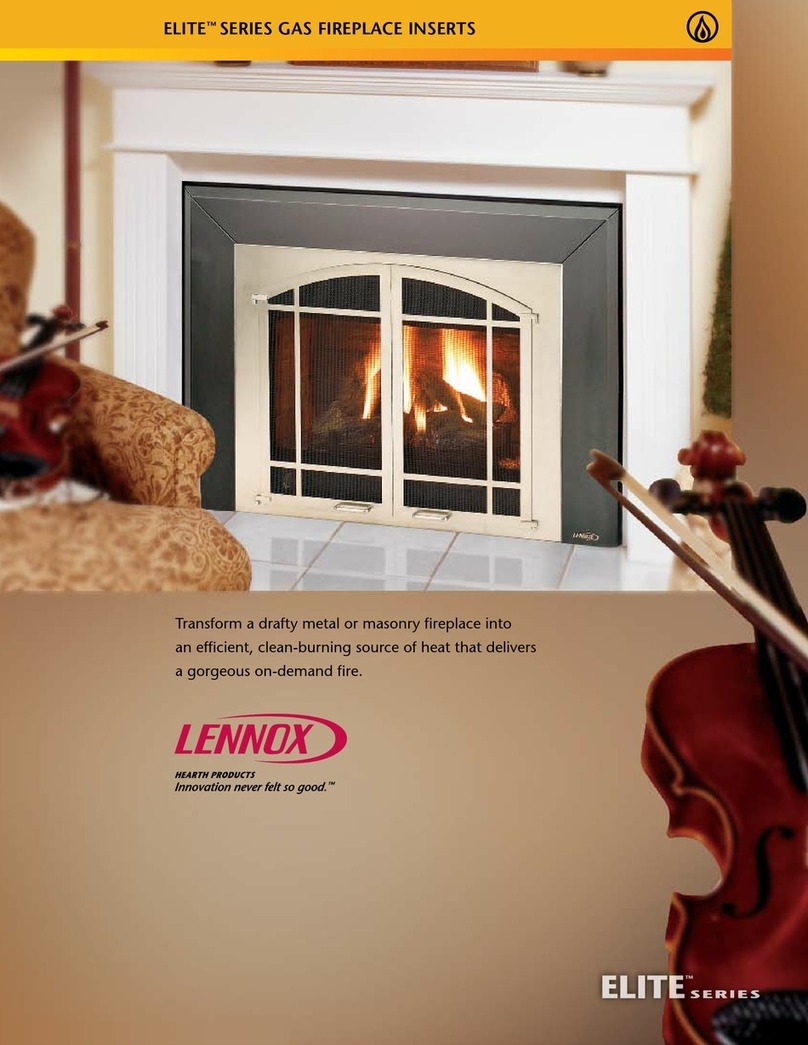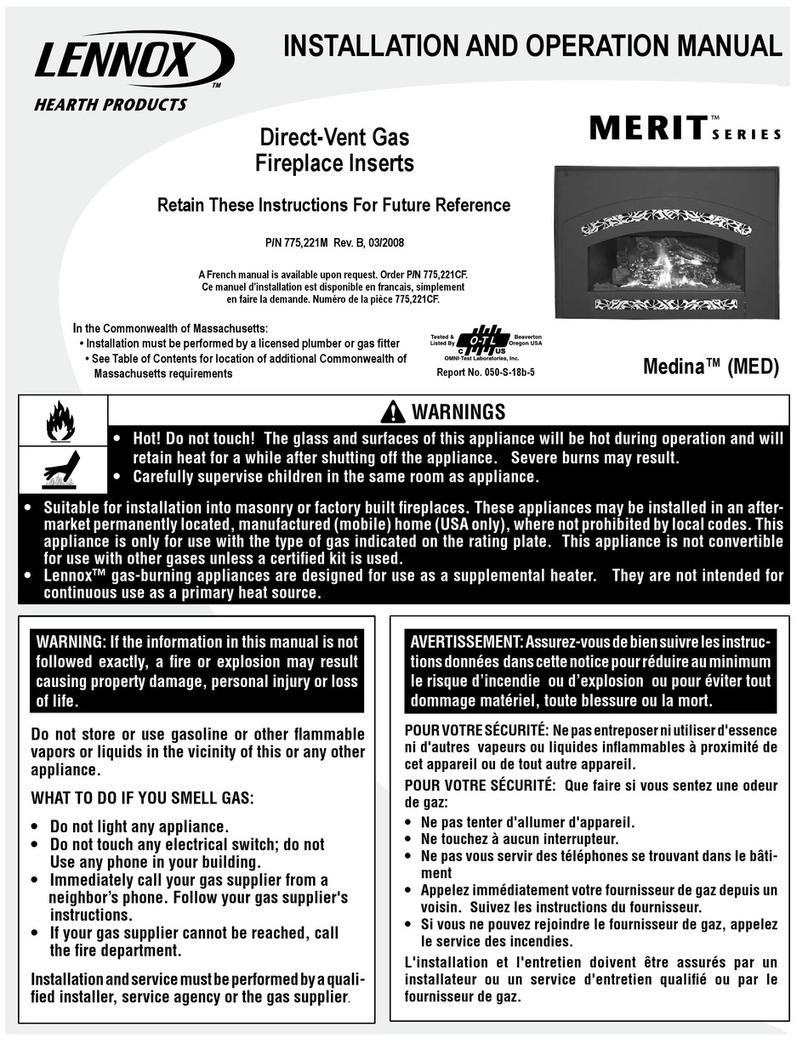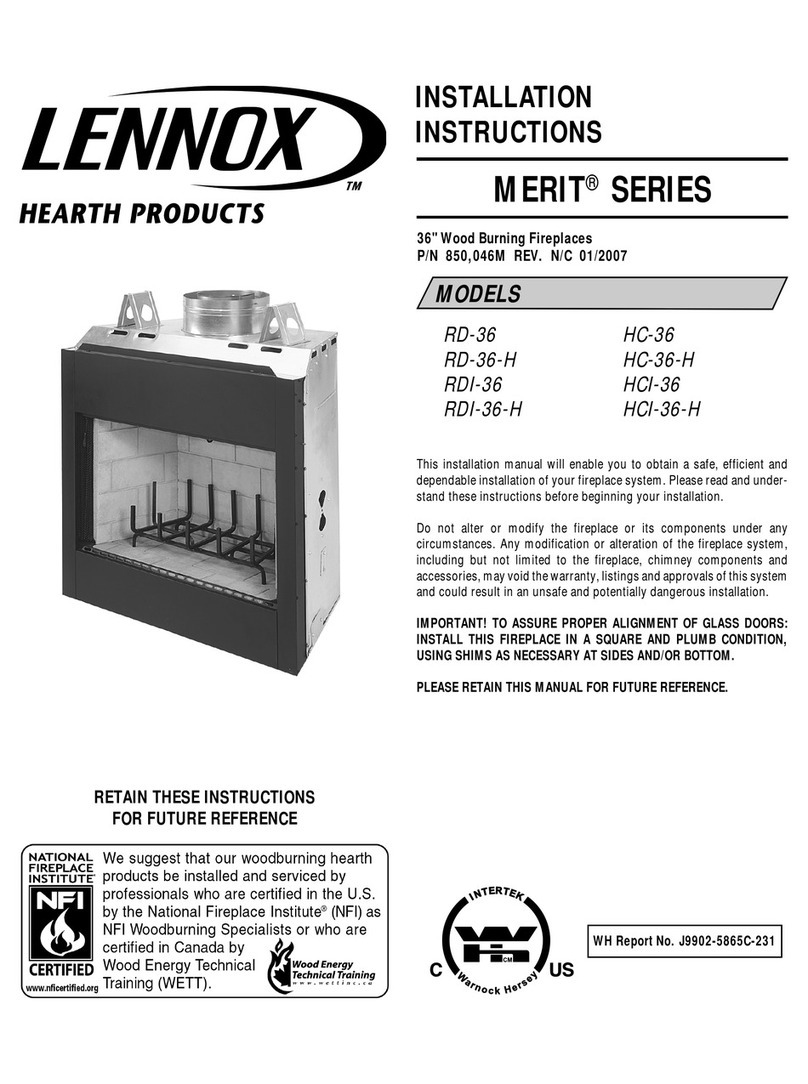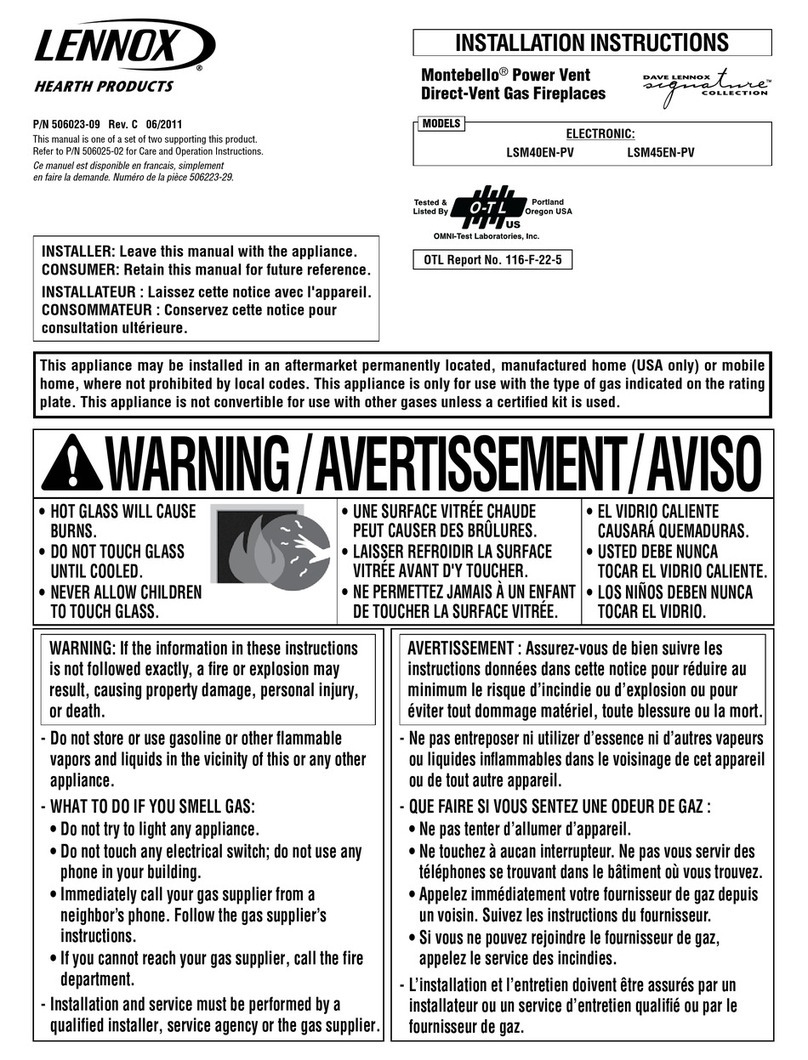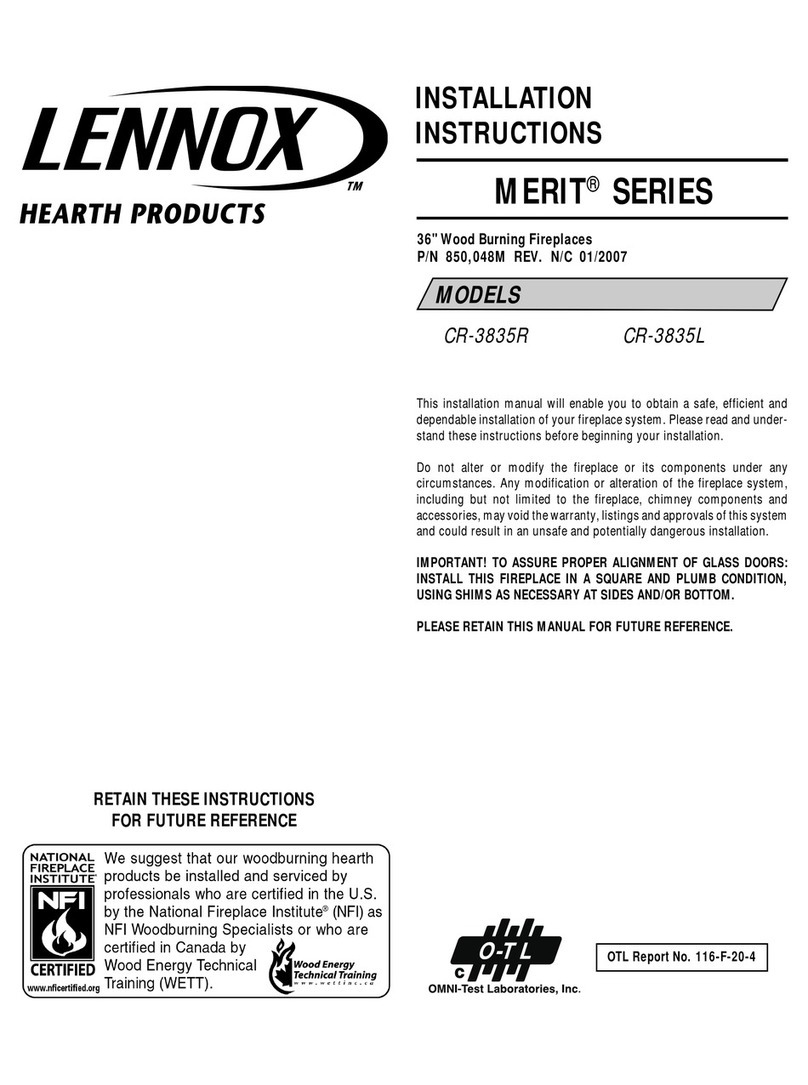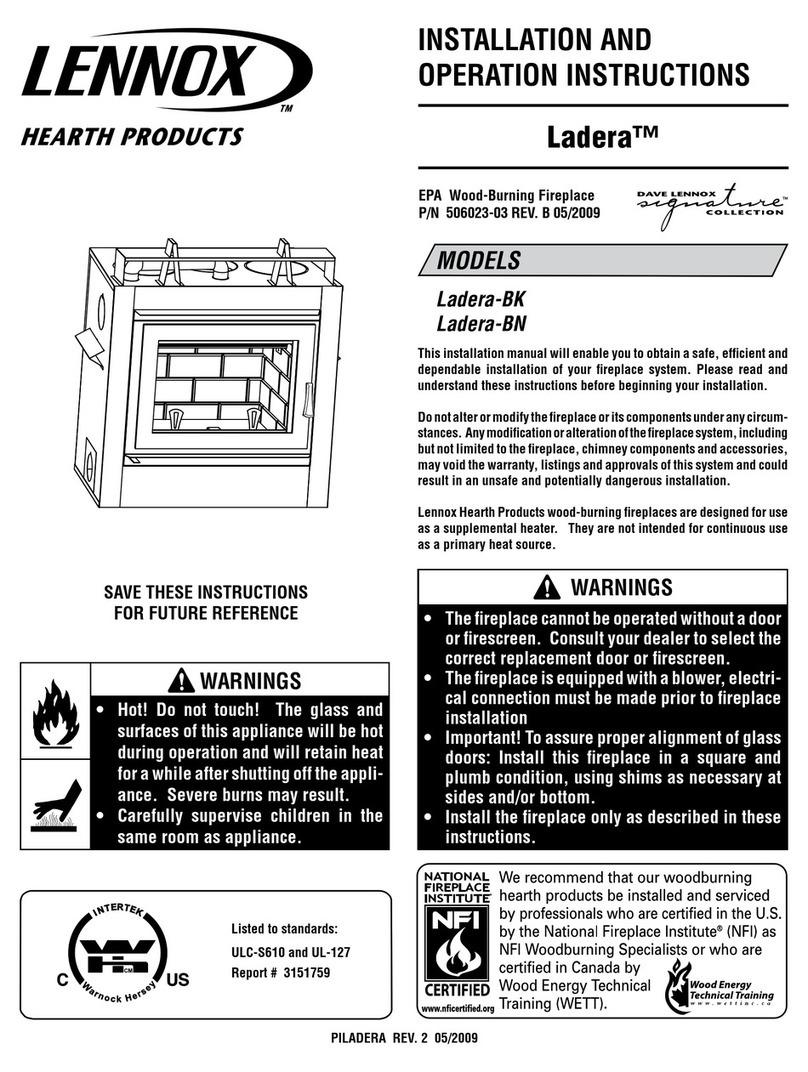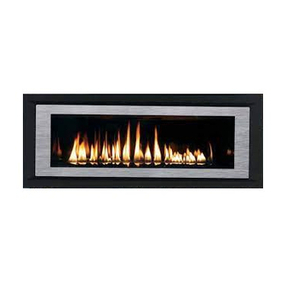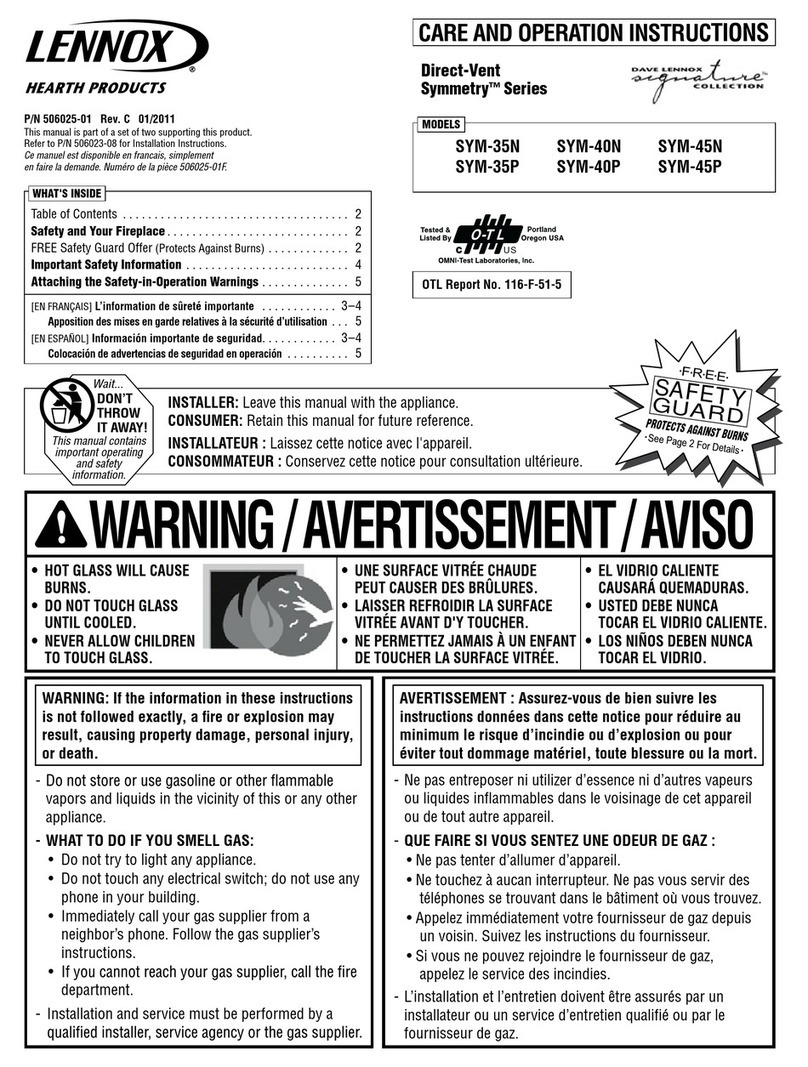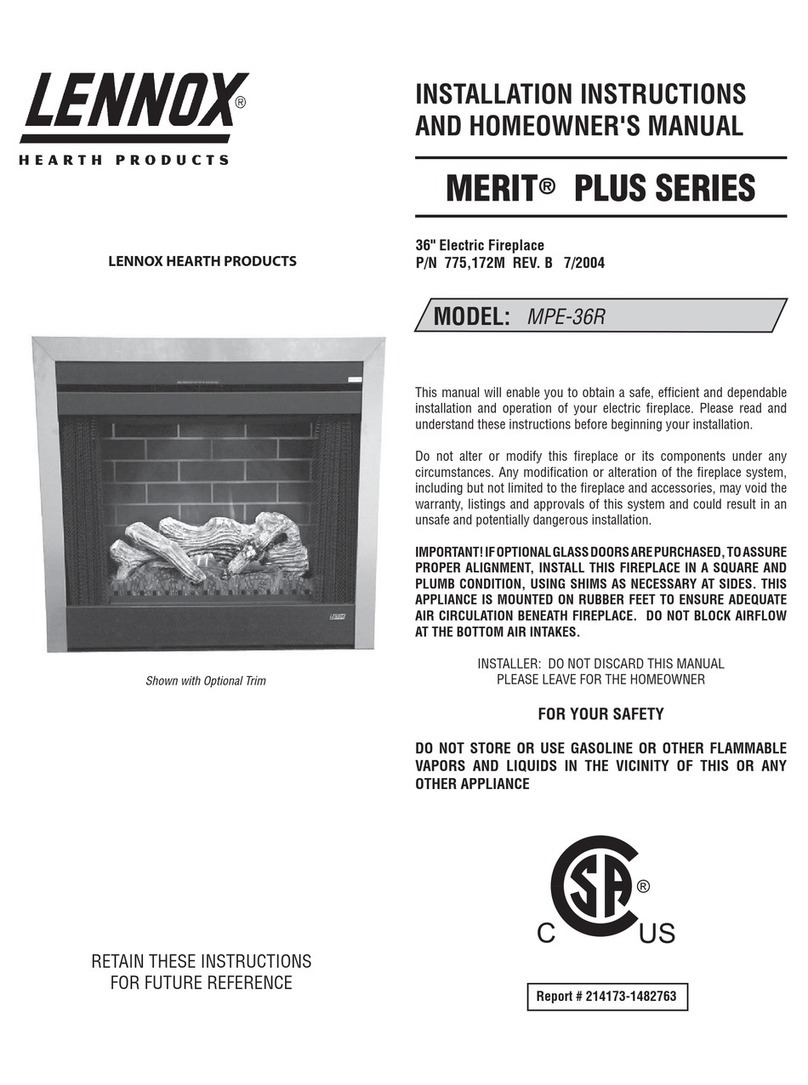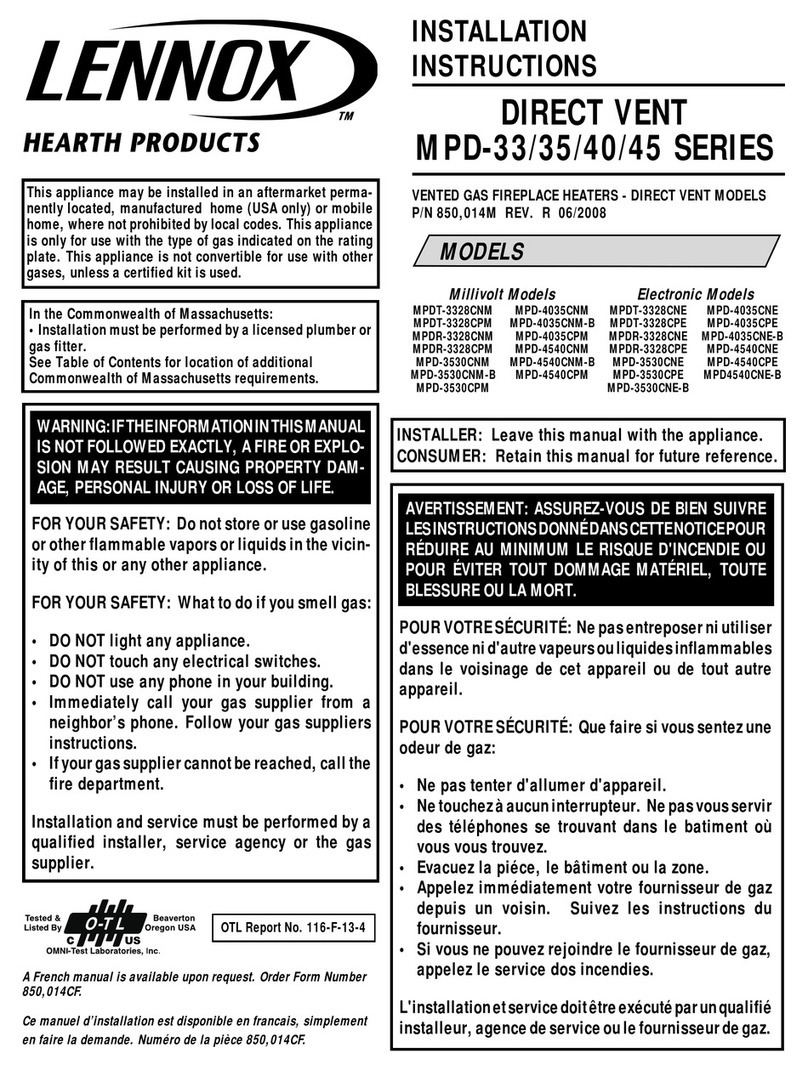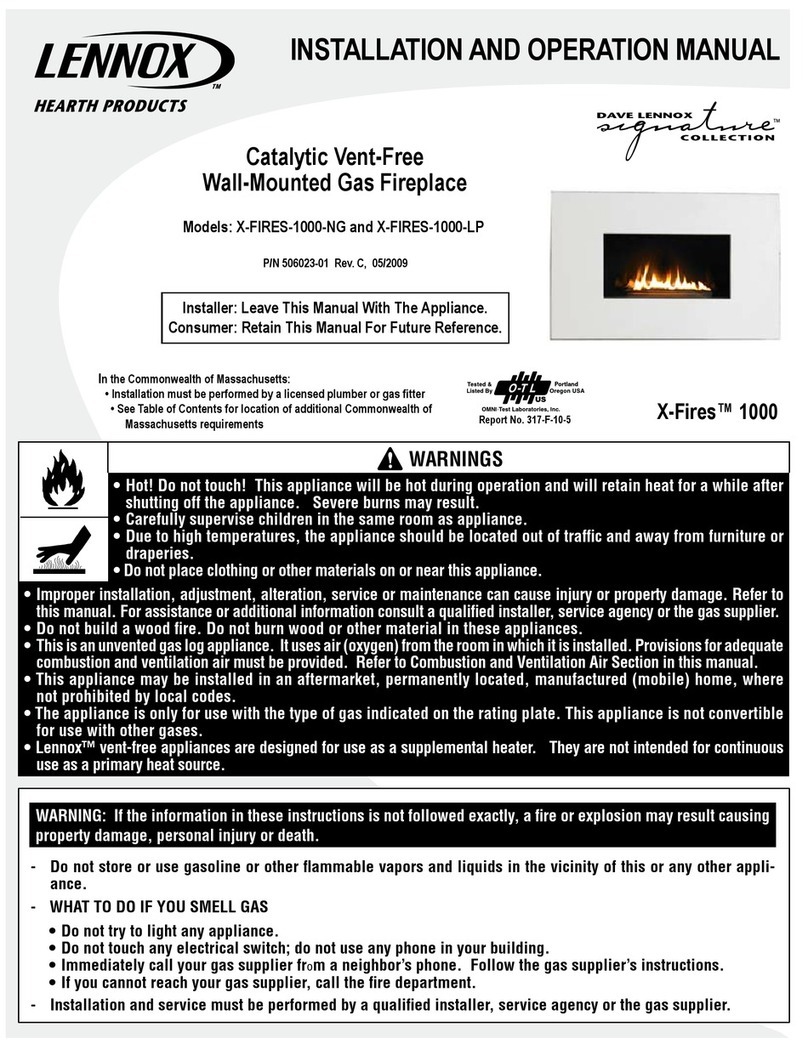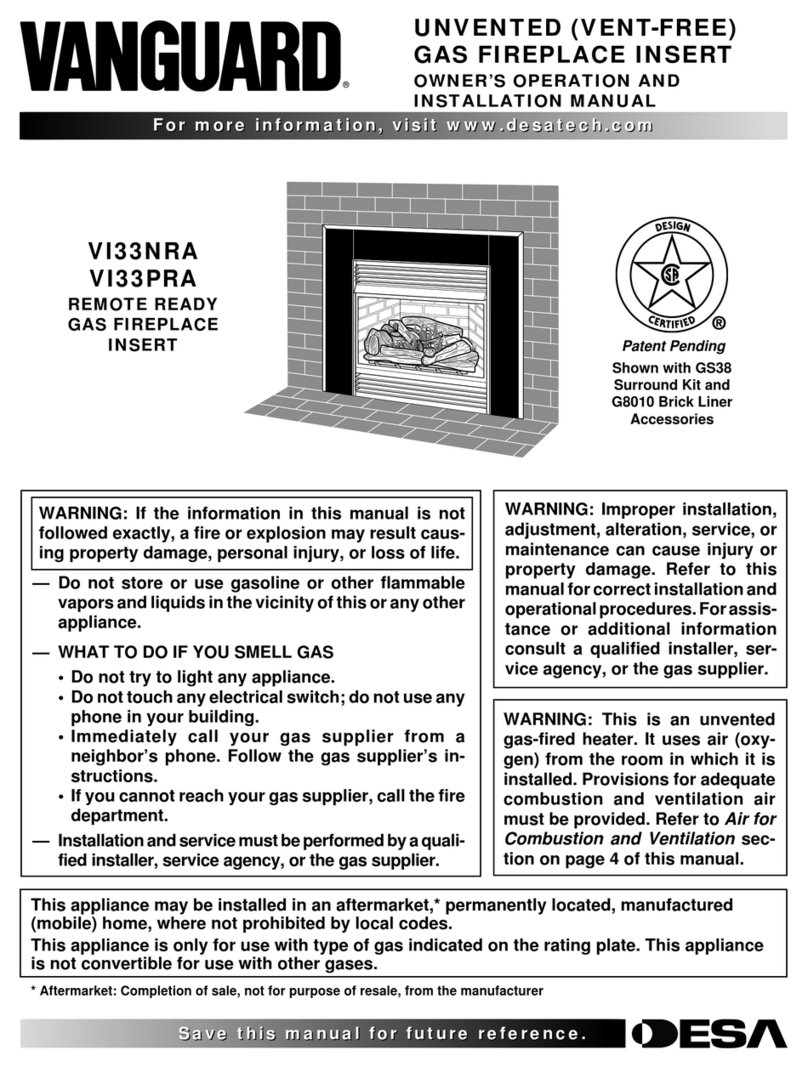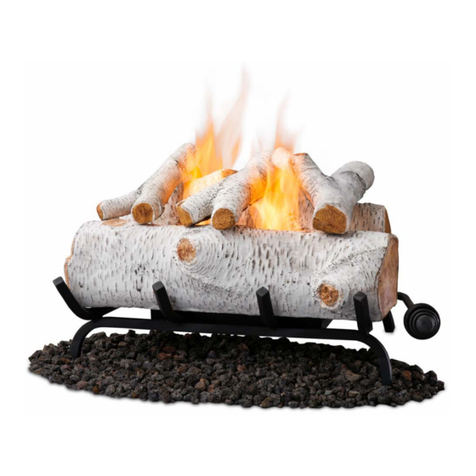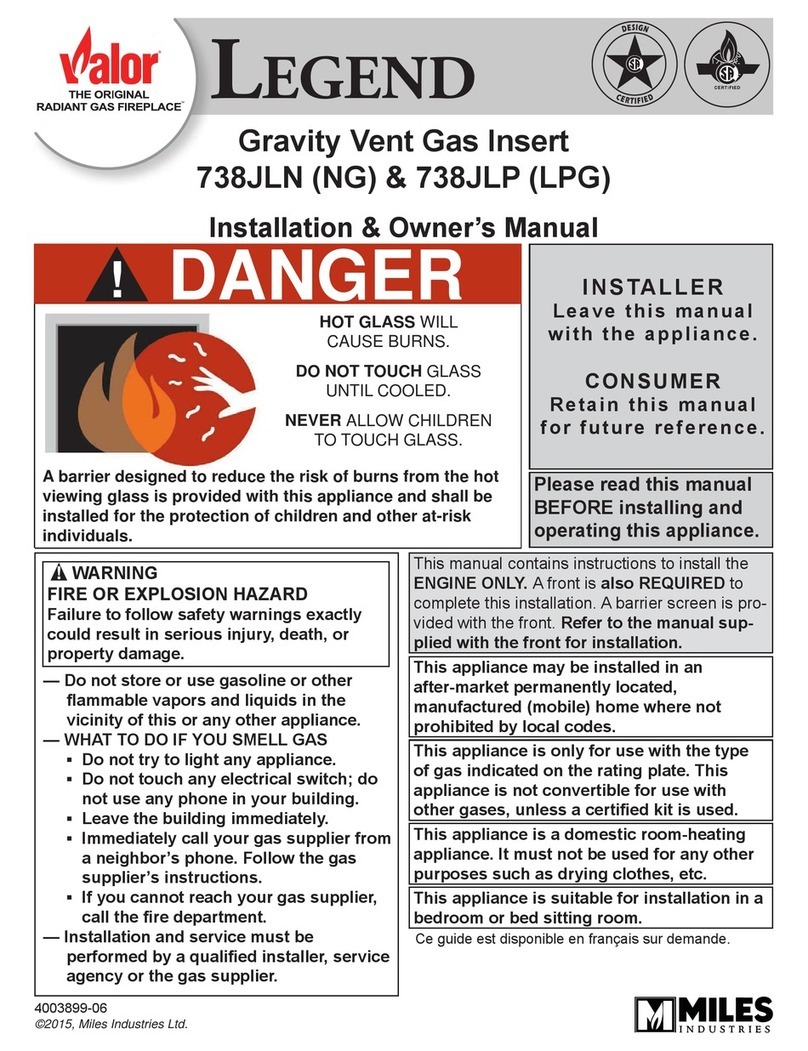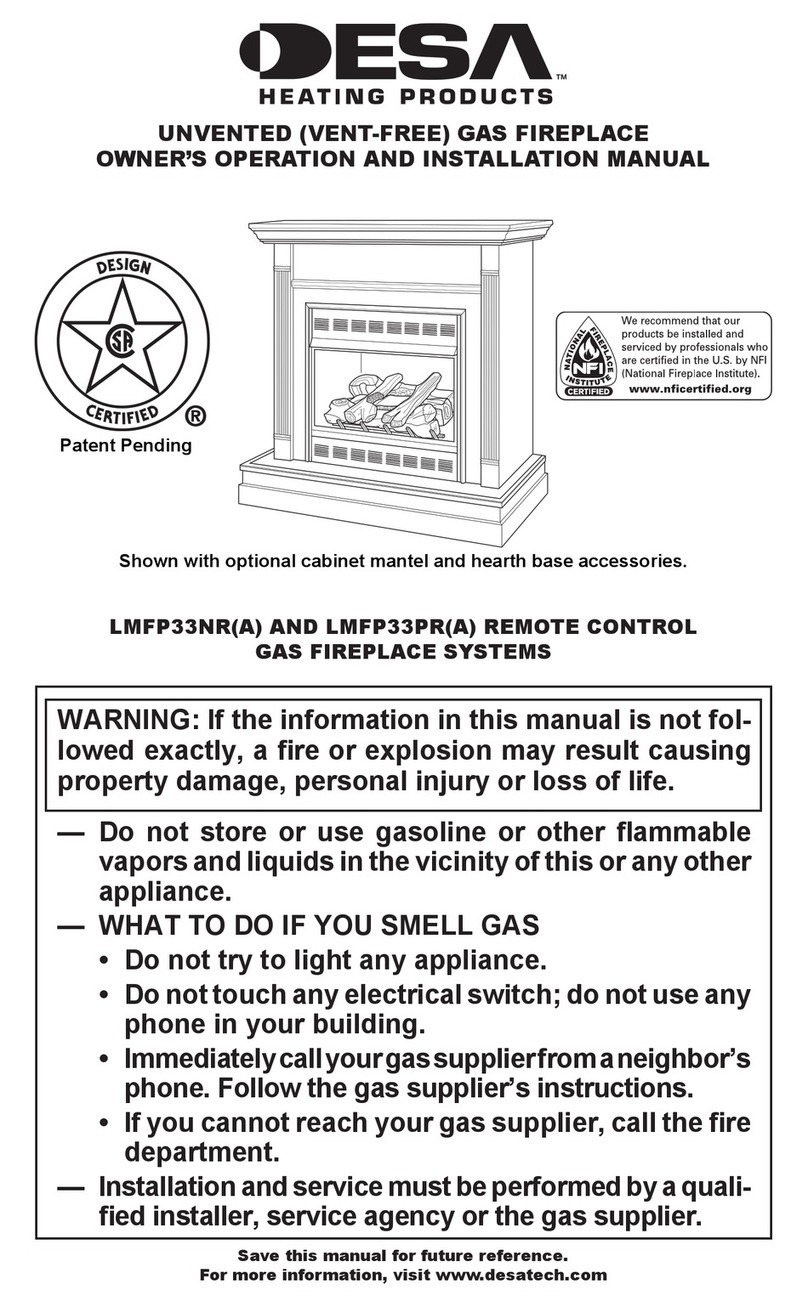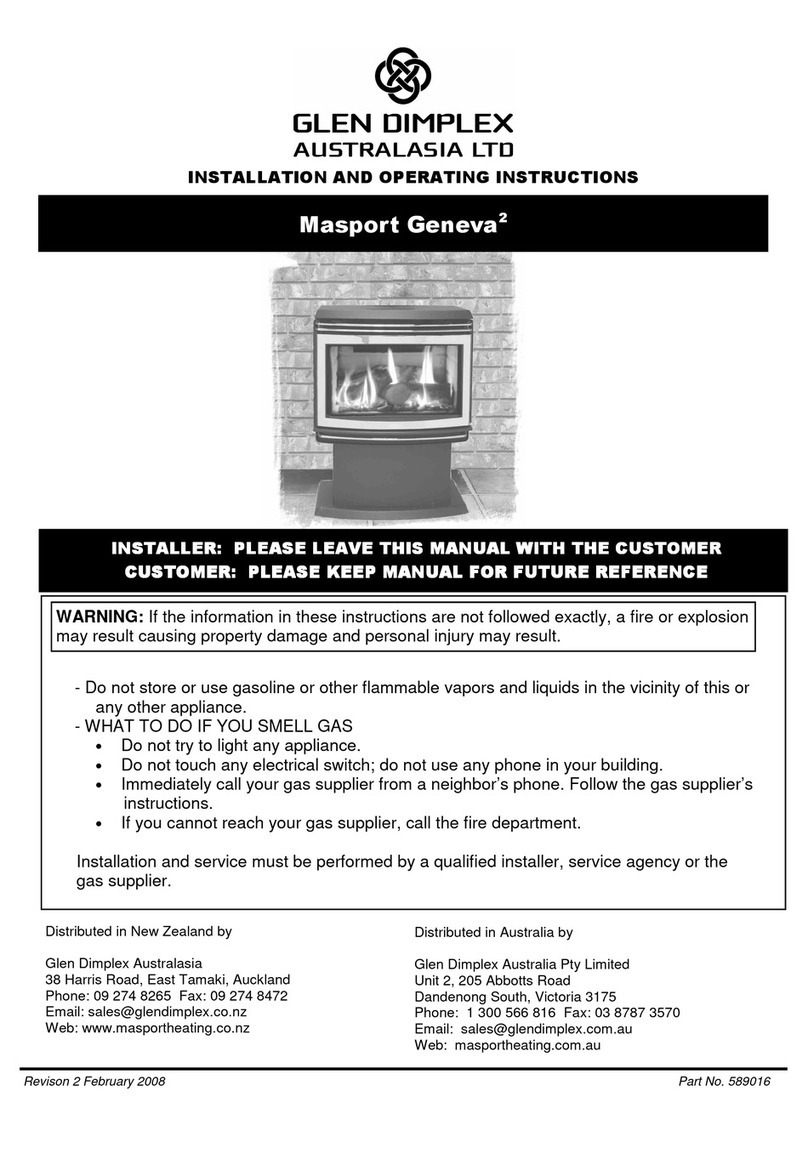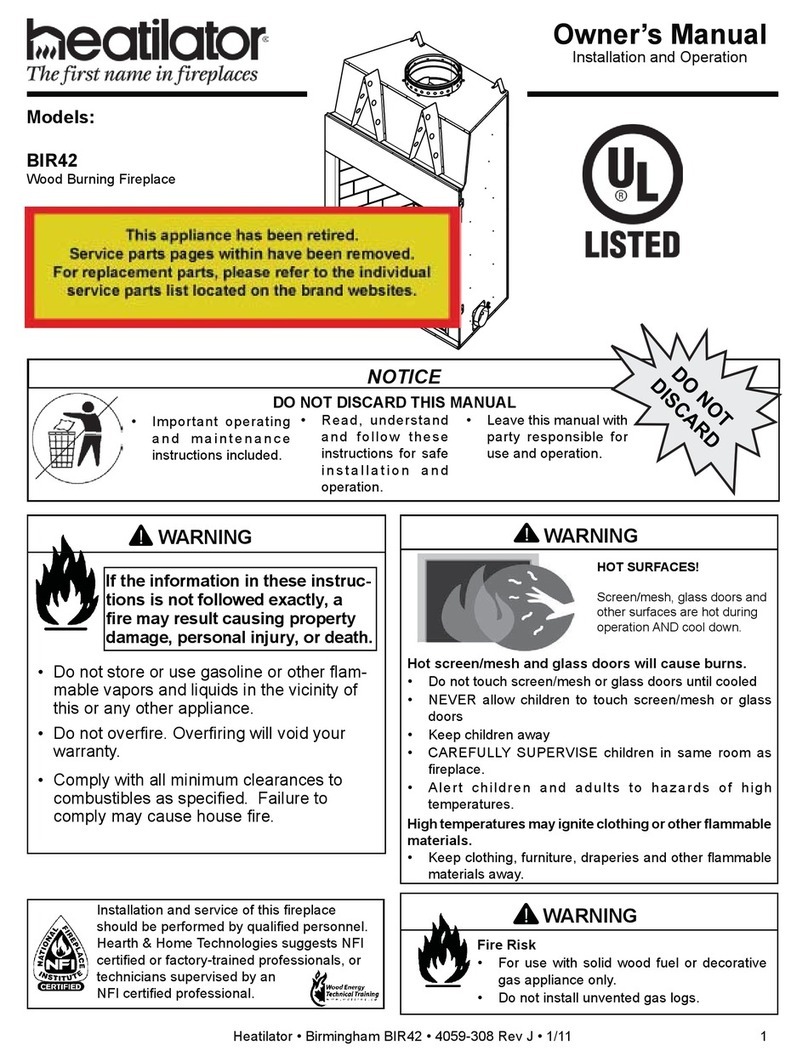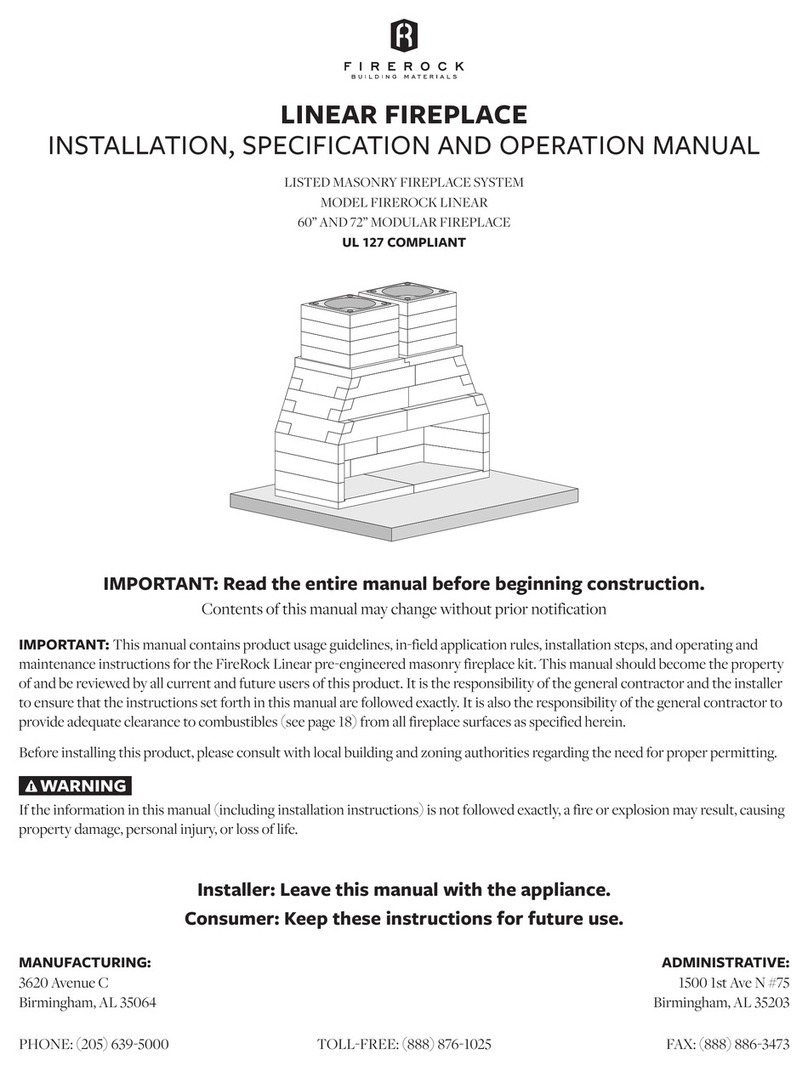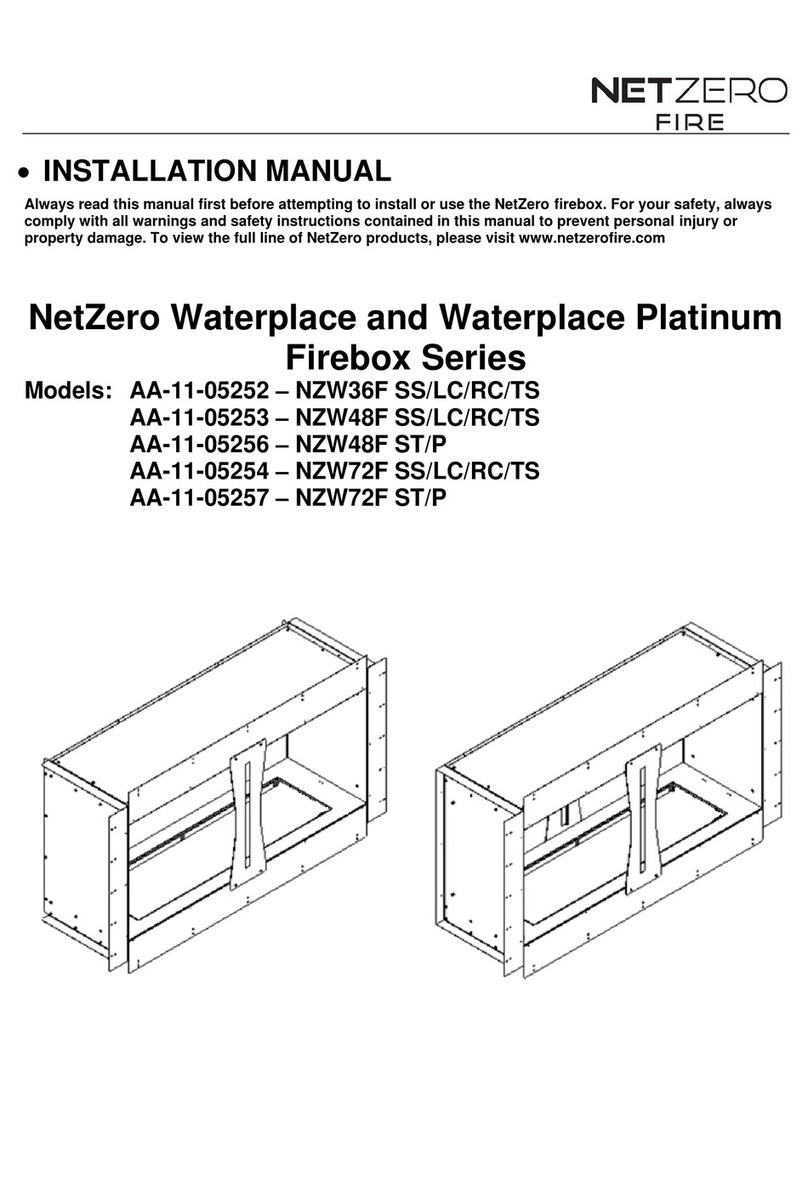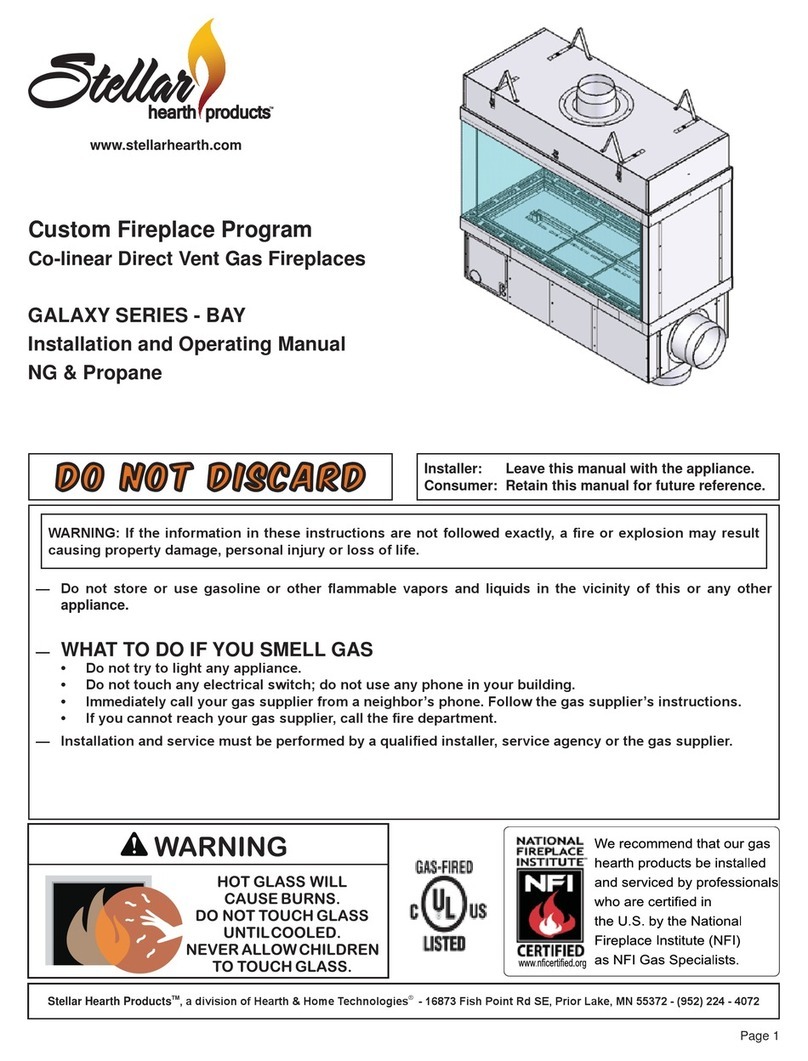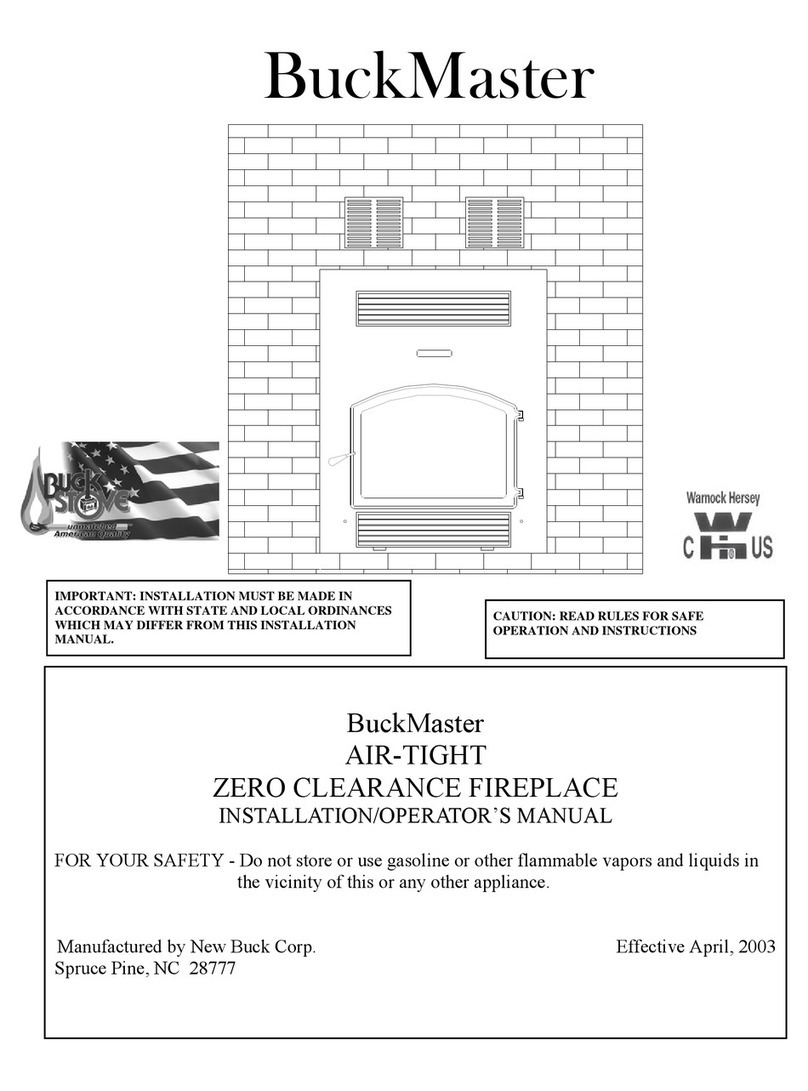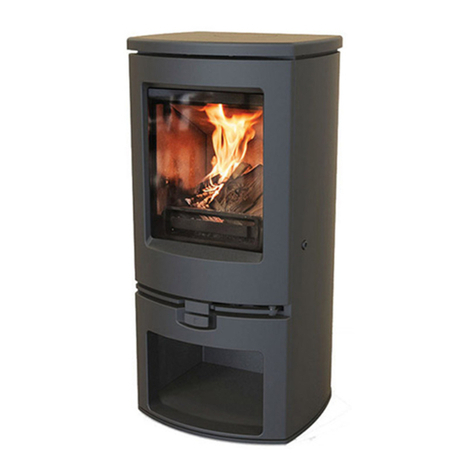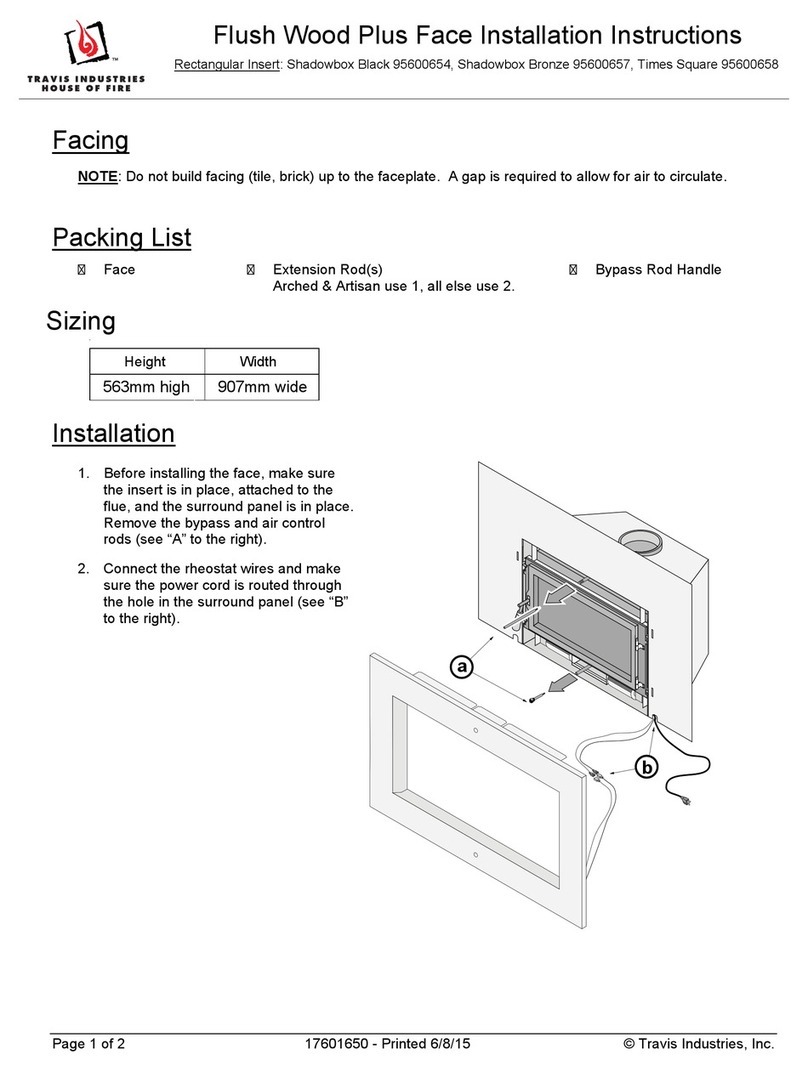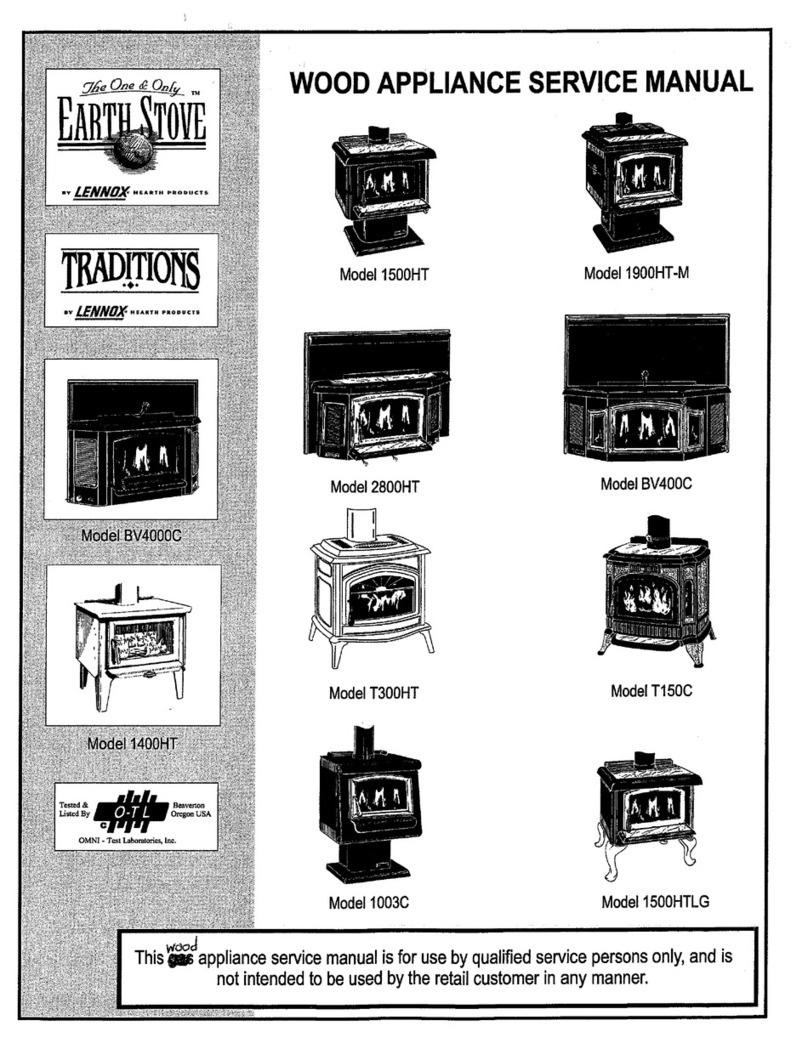
2NOTE: DIAGRAMS & ILLUSTRATIONS NOT TO SCALE.
TABLE OF CONTENTS
General Safety Precautions................ page 2
General Information........................... page 2
Fuels .................................................. page 2
Gas Logs ........................................... page 3
Disposal of Ashes .............................. page 3
Softwood vs Hardwood ..................... page 3
Starting a Fire .................................... page 4
Damper Control ................................. page 4
Glass Door Operating Safety
Precautions and Instructions ........... page 4
Combustion Air ................................. page 5
Refractories ....................................... page 5
Maintenance Guidelines ..................... page 6
Twice a Year Check-Up ...................... page 6
Creosote Formation and Removal...... page 6
Troubleshooting ................................ page 6
Warranty............................................ page 7
Product Reference Information ......... page 7
Replacement Parts ............................ page 7
Accessory Components ..................... page 7
Replacement Parts ............................ page 8
15. Neither the manufacturer nor the seller
warrants "smoke free" operation nor are they
responsibleforinadequatesystemdraftcaused
by mechanical systems, general construction
conditions, inadequate chimney heights, ad-
verse wind conditions and/or unusual
environmental factors or conditions beyond
our control.
GENERAL INFORMATION
1. The all-steel, multi-wall firebox is the heat
center of the system. It is well insulated for
safe clearance to combustibles.
2. The hearth floor and sidewalls of the firebox
are lined with a brick pattern reinforced refrac-
tory for the look of authenticity and to provide
safety.
3. Themetal chimney sections extending from
the firebox top to beyond your roof are two
walled and air-cooled. The inner passage, or
flue, provides the exit for smoke and gases.
4.Theflue damper is a twoposition(fullyopen
or fully closed) mechanism operated by a
handle found at the center top of the fireplace
opening. It must be open when fire is present
so smoke and gases can escape. It should be
closed ONLY when the fire is completely out –
keeping room air from being lost up the flue.
5. Closed screens prevent fire, sparks and
embers from popping out of the firebox while
a fire is burning. Pull screens back when
adding wood to the firebox.
6. Why use a fuel grate? Besides positioning
the firebed properly, it protects the refractory
floor, back and sides of the fireplace. Further,
it ensures a proper flow of combustion air into
and around the firebed. The grate must be
used at all times when burning. Your warranty
may be voided without the use of this grate.
7.Remember, your fireplaceis not intendedto
heat your entire home.
FUELS
Never Use Coal in Your Fireplace
Your fireplace system is not designed to be
used with coal derivative products. The com-
bustion process of certain types of coal can
deposit corrosive materials in the fireplace
and chimney system which can lead to prema-
ture product failure. Never use coal as a fuel in
this fireplace system.
3.Keepthechimneydamperopenwhileanyfire
or smoldering embers are present .
4. Never block or restrict the room air intake
grille across the bottom front or the warm air
outlet grille across the top front of the fireplace.
5.Usecarewhen selecting window treatments
for windows located near the fireplace. Avoid
usingcombustible flowingwindowtreatments
suchas curtains on nearby windows that are of
sufficientlengthtobeblown in front of an open
flame when the window is opened.
6. With the fire burning, close the protective
mesh screens to keep sparks and embers
INSIDE the firebox.
7. Keep any combustible furniture or decora-
tive pillows at least 36" (914 mm) from the
fireplace opening.
8. Never leave your fireplace unattended while
it is burning.
9. Be careful adding wood fuel to the fire or
handlingfireplace toolssuchasshovels, tongs
or pokers.
10. Never modify or alter your fireplace sys-
teminany way. Todo so may createa potential
fire hazard and void the Limited Warranty.
11. The bottom refractory can be cracked by
excessiveabusesuchas tossingheavylogsonto
the grate or gouging with fireplace tools. Exer-
cisecautionwhenaddingwoodtoyourfireplace.
12. DO NOT use a fireplace insert or any other
product not specified by the manufacturer for
use with this fireplace.
13.If you are using your fireplaceasa“decorative
appliance,” such as with a permanently installed
gas log set, the fireplace damper must be perma-
nentlyfixedintheopenposition.Listed“vent-free”
gaslog sets maybe used withthe damper closed.
14. Always ensure that an adequate supply of
replacement combustion air from the outside
of the house is accessible to the fire to support
normal combustion. Fireplaces consume large
volumes of air during the normal combustion
process. In the event the home is tightly sealed
with modern energy efficient features, the op-
tionalcombustion airkit may not provide all the
airrequiredtosupportcombustion. Neitherthe
manufacturer nor the seller are responsible for
any smoking or related problems that may
result from the lack of adequate combustion
air. It is the responsibility of the builder/con-
tractor to ensure that adequate combustion air
has been provided for the fireplace.
GENERAL SAFETY PRECAUTIONS
IMPORTANT! READ AND UNDER-
STANDBEFOREYOURFIRSTFIRE.
1. Use SOLID WOOD only for fuel. It is best to
use dry and well seasoned hardwood. Soft
woods tend to burn very quickly. DO NOT use
treated wood, charcoal, coal, trash, driftwood
or woods that have been dipped in tar, pitch,
pine tar, creosote, etc. Wood products made
with synthetic binders, such as plywood, pro-
duce abnormally high temperatures and
sputtering, smoking fires.
Never burn treated construction lumber or
scraps. Thesewoods burnexcessively hot and
may contain chemicals used to treat insects
and fungus. When burned, these chemicals
can pose a significant hazard.
2. NEVER use gasoline, gasoline-type lantern
fuel, kerosene, charcoal lighter fluid, or similar
liquids to start or “freshen up” a fire in this
fireplace. Keep any flammable liquids a safe
distance from the fireplace.
WARNING: DO NOT POKE OR STIR PRO-
CESSED SOLID FUEL LOGS WHILE THEY
ARE BURNING. ONLY USE LOGS THAT
HAVE BEEN EVALUATED FOR APPLICA-
TION IN THE FIREPLACE AND REFER TO
ALLFIRELOGWARNINGSANDCAUTIONS
MARKED ON THE PACKAGING.








